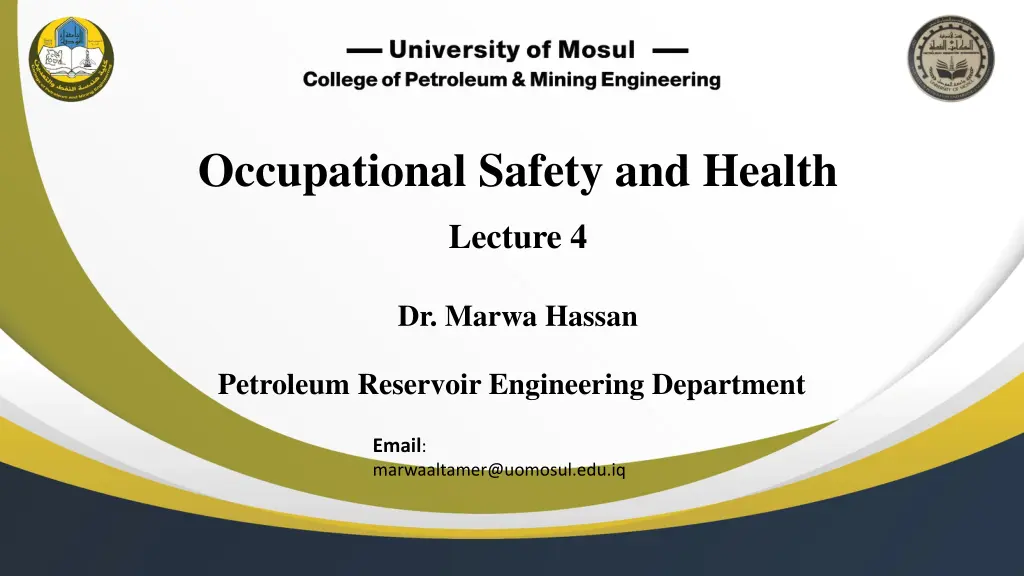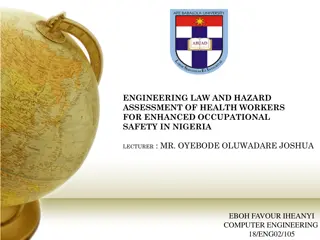
Understanding Occupational Safety and Health Hazards in the Workplace
Explore the lecture on falling, impact, acceleration, lifting, and vision hazards in the occupational safety and health field. Learn about common causes of falls, different kinds of falls, and the hazards posed by temperature extremes. Enhance your knowledge of thermal energy concepts and the effects of metabolic and environmental heat on human comfort and safety.
Download Presentation

Please find below an Image/Link to download the presentation.
The content on the website is provided AS IS for your information and personal use only. It may not be sold, licensed, or shared on other websites without obtaining consent from the author. If you encounter any issues during the download, it is possible that the publisher has removed the file from their server.
You are allowed to download the files provided on this website for personal or commercial use, subject to the condition that they are used lawfully. All files are the property of their respective owners.
The content on the website is provided AS IS for your information and personal use only. It may not be sold, licensed, or shared on other websites without obtaining consent from the author.
E N D
Presentation Transcript
Occupational Safety and Health Lecture 4 Dr. Marwa Hassan Petroleum Reservoir Engineering Department Email: marwaaltamer@uomosul.edu.iq
LECTURE CONTENTS Falling, Impact, Acceleration, Lifting, and Vision Hazards
Falling, Impact, Acceleration, Lifting, and Vision Hazards More than 16 % of all disabling work-related injuries are the result of falls. Clearly, falls are a major concern of safety and health professionals. The primary causes of falls are as follows: A foreign object on the walking surface A design flaw in the walking surface Slippery surfaces An individual s impaired physical condition
Kinds of Falls Trip and fall accidents occur when workers encounter an unseen foreign object in their path. When the employee s foot strikes the object, he or she trips and falls. Stump and fall accidents occur when a worker s foot suddenly meets a sticky surface or a defect in the walking surface. Step and fall accidents occur when a person s foot encounters an unexpected step down (for example, a hole in the floor or a floorboard that gives way). Slip and fall accidents occur when the worker s center of gravity is suddenly thrown out of balance (for example, an oily spot causes a foot to shoot out from under the worker). This is the most common type of fall.
Hazards of Temperature To understand fully the hazards posed by temperature extremes, safety and health professionals must be familiar with several basic concepts related to thermal energy. The most important of these are summarized here: Conduction is the transfer of heat between two bodies that are touching or from one location to another within a body. For example, if an employee touches a workpiece that has just been welded and is still hot, heat will be conducted from the workpiece to the hand. Of course, the result of this heat transfer is a burn. Convection is the transfer of heat from one location to another by way of a moving medium (a gas or a liquid). Convection ovens use this principle to transfer heat from an electrode by way of gases in the air to whatever is being baked.
Metabolic heat is produced within a body as a result of activity that burns energy. All humans produce metabolic heat. This is why a room that is comfortable when occupied by just a few people may become uncomfortable when it is crowded. Unless the thermostat is lowered to compensate, the metabolic heat of a crowd will cause the temperature of a room to rise to an uncomfortable level. Environmental heat is produced by external sources. Gas or electric heating systems produce environmental heat as do sources of electricity and a number of industrial processes. Radiant heat is the result of electromagnetic nonionizing energy that is transmitted through space without the movement of matter within that space.
Burns and Their Effects One of the most common hazards associated with heat in the workplace is the burn. Severity of Burns The severity of a burn depends on several factors. The most important of these is the depth to which the burn penetrates. Other determining factors include location of the burn, age of the victim, and amount of burned area. The most widely used method of classifying burns is by degree (i.e., first-, second-, or third-degree burns). Modern safety and health professionals should be familiar with these classifications and what they mean.
First-degree burns are minor and result only in a mild inflammation of the skin, known as erythema. Sunburn is a common form of first-degree burn. It is easily recognizable as a redness of the skin that makes the skin sensitive and moderately painful to the touch. Second-degree burns are easily recognizable from the blisters that form on the skin. If a second-degree burn is superficial, the skin will heal with little or no scarring. A deeper second-degree burn will form a thin layer of coagulated, dead cells that feels leathery to the touch. A temperature of approximately 98.9 C can cause a second-degree burn in as little as 15 seconds of contact. Third-degree burns are very dangerous and can be fatal depending on the amount of body surface affected. A third-degree burn penetrates through both the epidermis and the dermis. A deep third-degree burn will penetrate body tissue. Third-degree burns can be caused by both moist and dry hazards. Moist hazards include steam and hot liquids; these cause burns that appear white. Dry hazards include fire and hot objects or surfaces; these cause burns that appear black and charred.







